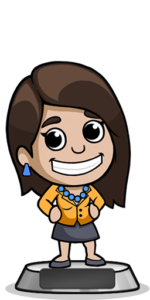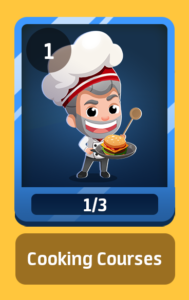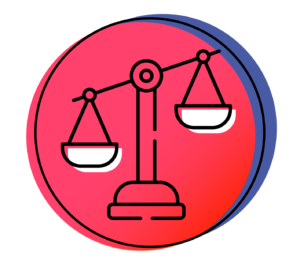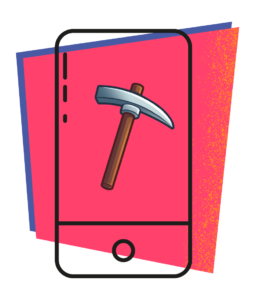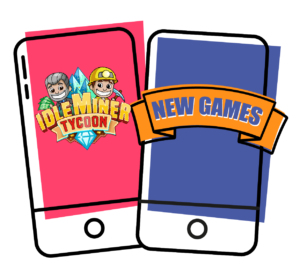- Game art, IMT
- Game art, IRT
One of Idle Miner Tycoon’s Super Managers, Mrs. Goodman, lowers your elevator upgrade costs by 90% for five minutes. In Idle Restaurant Tycoon, there’s a cooking course that gives your kitchens a permanent 2% revenue boost. Who comes up with these features? Who names the managers? And why does a restaurant simulation game have a collectible card mechanic? Enter the game designer. Game designers in general, and game designers at Kolibri Games wear a variety of different hats depending on which game they’re working on, and their tasks can even vary from sprint to sprint. Briefly said, however, it’s up to the game designers to write the rules of the game and make sure it’s fun and rewarding to play.
Becoming a game designer at Kolibri Games
In common with every role, prospective game designers start off with a recruiter screening call over Zoom. We do these over Zoom not just because we’re currently working from home, but also because we want to be able to look at candidates from all around the world. Our team is already made up of Kolibris from more than 40 different countries, and we’re not going to let geography get in the way of hiring the best talent. This first call is a general assessment of where you are in your career, what sparked your interest in Kolibri Games, your communication skills, how you see yourself growing in game design, and our first chance to see if there’s a fit.
Understand Balance
After the first call, there’s a test on balancing and general F2P industry knowledge. For experienced game designers this should need no explanation, but we’re going to be talking about balancing a lot in this article so let’s dive in. As a game designer at Kolibri Games balancing will be a big part of your job. Balancing, in short, is making sure that all of the different game mechanics interact in the most fun and, because we are a F2P company, profitable way.
In a racing game for example, if there was one car that was always faster than the others, it would likely be considered “unbalanced”. In Idle Miner Tycoon (IMT) we don’t have cars but we have active and passive boosts, Super Managers, a collectible card mechanic, expeditions, a skill tree, Artifacts, milestone rewards, multiple currencies and a lot more. The effects of each of these need to be balanced against all the others and feel rewarding to use. We want different players to pick their own play style and feel like their choices are fun and meaningful – and not worry that they’re doing it wrong because they like expeditions more than the skill tree. We don’t want to have the one all-powerful boost that, like the car in the racing example, renders all other choices less valuable.
This is balancing and getting it right is a matter of both art and math. There is no such thing as a “perfectly balanced” game. One of the benefits of working on a live game, as all of ours are, is that we have the opportunity to continually balance them as we add new features and observe player behaviour. Your balancing test will be based on one of our titles and require you to dive into some spreadsheets and make judgement calls. In terms of your results, we’re not necessarily looking for the right answer. Instead, we’re looking at your process and your ability to explain your decisions.
Play our games
After the balancing test, there are two rounds of interviews, one with our Lead Game Designer and one with a Product Lead or Director who would be your lead. These calls are further opportunities for you to get to know us and for us to get to know you. A good cultural fit works both ways and we want you to learn as much about us as we hope to learn about you. Come prepared for these calls. In other words: play our games! If you’re interviewing for a position on IMT, play it. If you’re interviewing for a new games team, play a bunch of our games and take note of how they’re different from each other. It’s not important that you’ve played 50 hours of each of our titles, but there are some mechanics that don’t kick in until you’ve spent some time in them. If you’re time-constrained, there is a lot of IMT information online, both from us and from players. Do the research! This research also includes other mobile idle games.
Play other games
As a game designer, we expect you to be passionate about gaming – especially mobile games and, even more so, mobile idle games. All of our titles are live games, which means we’re continually updating them, iterating on them, and improving them. In order to be successful we need to both lead in the idle space and react to changes in it. The best way to stay in touch with this space is, naturally, to play a lot of mobile idle games. But don’t stop there! The best game designers take inspiration from games outside their genre, from non-gaming media and from sources we might never expect. In your interviews, we want to hear about what excites you, what games and media have shaped you and how you want to make your own impact in gaming.
Trial days
Your interviews have gone great and it’s time for your two-day trial. These have traditionally been done in-person, in the office and we hope to be able to do that again soon. For now, they’re via Zoom – one benefit of which is that it makes it even easier for international applicants. Your first day’s task will be another exercise in balancing and on your second day you’ll be doing high-level feature design. We won’t give away more details on the tasks, but one huge tip for your trial is to talk to us. Communication is key, both inside Kolibri Games in general and for our game designers. In the words of Boris, our Lead Game Designer, “you can fail your trial when you’ve produced a good solution but didn’t interact with the team.”
Here’s a link to post about our trial days.
Reach out to the team during your trial days. Ask questions, get input, act like a member of the team. No one expects you to know everything about our games, no matter how much you’ve played them. We want to hear from you and we’re happy to answer your questions.
This emphasis on communication carries over to your presentation at the end of each trial day. You’ll be expected to pitch your results, and your audience will include Kolibris from a range of different departments. On your balancing exercise for example, you’ll crunch a lot of numbers to reach your solution – but don’t just pitch us your Excel sheet. Be prepared to boil down your math and reasoning to a level that’s clear to every member of the team, regardless of their math or analytics backgrounds. Show us – and sell us – your work. The way you got to your result is as valuable as your result itself.
New Games vs IMT
We hire for both IMT and our new games teams, and at a variety of seniority levels. When we bring a game designer onto the IMT team, they’re going to be working on an established title with established mechanics. The odds of us bringing you on-board to develop an IMT first-person driving minigame are pretty slim. You’ll spend a lot of your time balancing. IMT game design roles tend to be more senior and analytics-heavy as it’s a mature product with a great deal of data to work with. You’ll work closely with our data teams as you analyse how different systems work together and impact the player experience. The decisions you make here will affect millions of players, many of whom actively dissect our updates and balancing changes, as they seek to perfect their game strategites.
Game designers on our new games teams have more generalist roles, as we are still building new gameplay elements and shaping the next generation of idle games. Game designers are sometimes shared between our various new games teams, as different games are in different stages of development. In addition to the ever-important balancing work, you’ll be doing UI, screenflows, mockups, localization, and – remember how we stressed communication earlier – documenting it all. Documentation is a key part of our design process as it encourages knowledge sharing within and between all of our product teams.
Ready to join the team?
Hopefully this post has gotten you excited about the prospect of helping us build the most fun and player-centric idle games on the market. If so, take a look at our featured jobs below and all of our openings on our careers page.
We can’t wait to hear from you.
